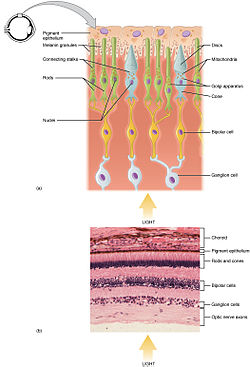
Photoreceptor cell
Type of neuroepithelial cell / From Wikipedia, the free encyclopedia
Dear Wikiwand AI, let's keep it short by simply answering these key questions:
Can you list the top facts and stats about Photoreceptor cell?
Summarize this article for a 10 year old
A photoreceptor cell is a specialized type of neuroepithelial cell found in the retina that is capable of visual phototransduction. The great biological importance of photoreceptors is that they convert light (visible electromagnetic radiation) into signals that can stimulate biological processes. To be more specific, photoreceptor proteins in the cell absorb photons, triggering a change in the cell's membrane potential.
| Photoreceptor cell | |
|---|---|
 | |
| Identifiers | |
| MeSH | D010786 |
| NeuroLex ID | sao226523927 |
| FMA | 85613 86740, 85613 |
| Anatomical terms of neuroanatomy | |
There are currently three known types of photoreceptor cells in mammalian eyes: rods, cones, and intrinsically photosensitive retinal ganglion cells. The two classic photoreceptor cells are rods and cones, each contributing information used by the visual system to form an image of the environment, sight. Rods primarily mediate scotopic vision (dim conditions) whereas cones primarily mediate photopic vision (bright conditions), but the processes in each that supports phototransduction is similar.[1] The intrinsically photosensitive retinal ganglion cells were discovered during the 1990s.[2] These cells are thought not to contribute to sight directly, but have a role in the entrainment of the circadian rhythm and the pupillary reflex.